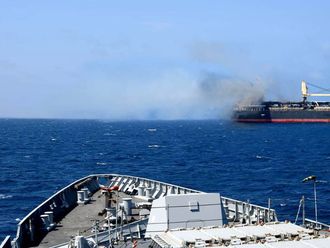Sana'a: While domestic insurgencies chip away at the control of Yemen's central government and an Al Qaida branch gains strength in regions beyond the government's reach, another crisis — one that affects Yemen's entire population — has the potential to contribute to the country's instability and potential trajectory toward failure.
Yemen is running out of water — fast.
But the water crisis and the rise of militancy are not unrelated perils said Abdul Rahman Al Eryani, Yemen's minister of Water and Environment, in an interview. Much of the country's rising militancy, he argues, is a conflict over resources.
Different ways
"They manifest themselves in very different ways: tribal conflicts, sectarian conflicts, political conflicts. Really they are all about sharing and participating in the resources of the country, either oil, or water and land," said Al Eryani. "Some researchers from Sana'a University had very alarming figures. They said that between 70-80 per cent of all rural conflicts in Yemen are related to water."
Khalid Al Thour, a geology professor at Sana'a University, adds that recent reports have indicated that Sana'a's wells will run dry by 2015 at current water-usage rates.
In their 2009 Failed States Index, Foreign Policy magazine topped their analysis with a sobering assessment of Yemen as "a perfect storm of state failure", including disappearing oil and water reserves.
The World Bank considers Yemen "one of the most water-scarce countries in the world" where only 125 cubic metres of water are available yearly per capita compared to the world average of 2,500 cubic metres. Just 46 per cent of Yemen's rural population has direct access to an adequate water supply and the number is only slighter better in cities, according to the German Development Service (GDS), which is working with the Yemeni government to improve water management.
Public access to water is particularly sparse in Taiz, Yemen's third-largest city, where access to public water tanks is allowed only once every 45 days.
Charity
When households run out of their personal water supply they have the option to buy water from private companies but in Yemen, where 42 per cent of the population lives beneath the poverty line, many rely on charity from mosques to meet their needs, says Dierk Schlutter, coordinator for water and environment for GDS.
Yemen's population of 23 million has almost tripled since 1975, according to UN statistics, and available water resources simply cannot cope.
The soaring population paired with poor management of water resources has led to what Al Thour calls a "disastrous situation".
He says that the illegal drilling of wells into natural groundwater aquifers is increasing at an alarming rate and leaky pipes that waste up to 60 per cent of water in urban areas are major culprits. Although water usage regulations are in place to tackle these issues, the government lacks the ability to enforce them.
"We have a war and we have all these troubles so the government doesn't want to think about water," says Al Thour.
"There is enough water for provision of a city of 2 million like Sana'a, if the people don't drill illegally in the outskirts and take the water for irrigation of a cash crop like qat," says Schlutter. "It's a very complicated social issue because of the social value of qat chewing in this society."
Experts say potential solutions to Yemen's water crisis include increasing the implementation of rainwater harvesting in rural areas and modern irrigation techniques that waste less water than current methods.
Reluctance
However, the challenge is convincing Yemenis that these changes to the status quo will bring economic benefits as well.
"You don't need to tell people who are fighting everyday to get water that there is a crisis. What is lacking is providing them with alternatives and options about what they should do," said Al Eryani.
"The main problem is that you have to create incentives, even if people understand what they should do if there is no incentive they wont do it ... and the best incentive of course is economic."
Dismal scenario: Recipe for disaster
- 125 cubic metres of water available per capita
- 2,500 cubic metres per capita is world average availability
- 46% of rural Yemenis have direct access to water












